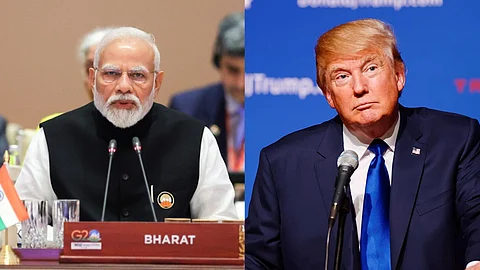
- Home
- न्यूजग्राम
- NewsGram USA
- India
- World
- Politics
- Entertainment
- Culture
- Lifestyle
- Economy
- Sports
- Sp. Coverage
- Misc.
- NewsGram Exclusive
- Jobs / Internships

Key Points:
President Trump signed an order imposing an additional 25% tariff on Indian goods over continued Russian oil and arms imports.
India’s Ministry of External Affairs criticized the tariffs as "unfair, unjustified, and unreasonable,"
Prime Minister Narendra Modi stated India will not compromise on the interests of its farmers, fishermen, and dairy sector
New Delhi, August 7, 2025 – U.S. President Donald Trump signed an executive order on August 6, 2025, imposing an additional 25% tariff on Indian goods, raising the total tariff on Indian imports to the United States to 50%. This follows a previous 25% tariff announced on July 30, 2025, as a penalty for India’s continued purchase of Russian oil and military equipment. The move escalates trade tensions between the two nations, with the statement from the Indian Government calling the tariffs “unfair, unjustified, and unreasonable.”
The executive order, effective August 27, 2025, cites India’s imports of Russian oil as undermining U.S. efforts to counter Russia’s actions in Ukraine, which the U.S. deems a “national emergency.” Trump stated in a CNBC interview on August 5, 2025, that India “has not been a good trading partner” due to its trade surplus with the U.S. and its purchase of Russian oil, which he claims fuels Russia’s “war machine.” The U.S. argues that India’s resale of Russian oil on the open market further supports Russia’s economy.
India’s Ministry of External Affairs responded swiftly, defending its oil imports as driven by market factors and the need to ensure energy security for its 1.4 billion citizens. The ministry highlighted that India began importing Russian oil after traditional supplies were diverted to Europe following the Russia-Ukraine conflict in 2022.
It noted that the U.S. had initially encouraged such imports to stabilize global energy markets. The statement emphasized that other countries, including the U.S. and EU nations, continue to import Russian goods, such as uranium, palladium, and LNG, questioning the selective targeting of India.
Russia has emerged as India’s top oil supplier, accounting for over 35% of India’s crude oil imports, approximately 1.75 million barrels per day in the first half of 2025, according to Kpler data. This marks a significant shift from pre-2022 levels when Russian oil comprised just 0.2% of India’s imports. India argues that these imports are critical to maintaining affordable energy prices for its population.
Prime Minister Narendra Modi, speaking at the MS Swaminathan Centenary International Conference in Delhi, reaffirmed India’s commitment to protecting its national interests, particularly those of its farmers, fishermen, and dairy sector.
“India will never compromise on the interests of farmers, fishermen, and dairy farmers. I know we will have to pay a heavy price for it, and I am ready for it. India is ready for it,” Modi declared, signalling resilience in the face of economic pressure.
The 50% tariff, one of the highest imposed by the U.S. on any trading partner, is expected to impact $64 billion of India’s $81 billion exports to the U.S. in 2024, including pharmaceuticals, textiles, and gems. Indian officials are assessing relief measures, such as interest subsidies and loan guarantees for exporters, to mitigate potential losses. A senior official indicated that the 21-day window before the tariff takes effect provides an opportunity for negotiations, though no immediate plans for retaliatory tariffs were announced.
India has accused the U.S. of inconsistent application of sanctions, pointing out that the EU imported 67.5 billion euros worth of Russian LNG in 2024, while the U.S. continues to import Russian uranium and fertilizers.
The tariff escalation follows failed trade talks between the U.S. and India, despite earlier optimism. With China, Turkey, and other nations also importing Russian oil, Trump’s order directs U.S. officials to monitor and potentially penalize other countries, hinting at broader trade actions. India remains committed to safeguarding its energy security and national interests amid these challenges. [Rh/Eth/VS]
Also Read:
